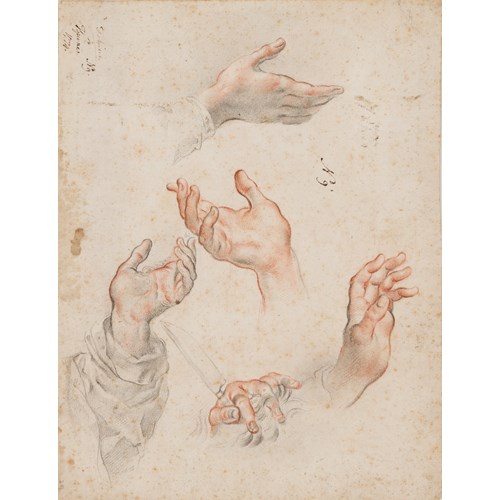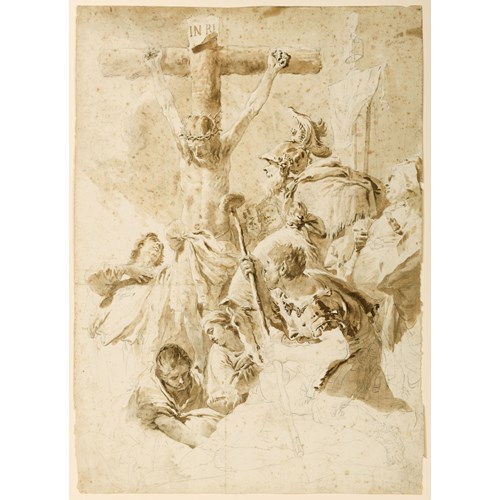Marketplace
Visage
Henri Matisse
Visage
Period 20th century
Medium Black ink on yellow paper, Hinged onto a sheet of white paper
Dimension 7.6 x 11.9 cm (3 x 4⁵/₈ inches)
Working primarily in ink and charcoal, Henri Matisse placed drawing almost on a level with painting as a form of artistic expression, noting that ‘For me, drawing is a painting made with reduced means.’ Perhaps nothing characterizes Matisse’s drawings better than his numerous line drawings executed with a brush or pen. As the artist wrote, ‘My line drawing is the purest and most direct translation of my emotion. The simplification of the medium allows that. At the same time, these drawings are more complete than they may appear to some people who confuse them with a sketch. They generate light...’
Beginning in the late 1940s, Matisse became extremely interested in masks, strongly influencing his manner of drawing faces. In 1954, a few months before his death, he was asked to write an introductory essay to accompany the publication of a folio of reproductions of his portrait paintings and drawings. As he wrote: ‘The human face has always greatly interested me. I have indeed a rather remarkable memory for faces, even for those I have seen only once. In looking at them I do not perform any psychological interpretation, but I am struck by their individual and profound expression…The driving force which leads me throughout the execution of a portrait depends on the initial shock of contemplating a face…I ended up discovering that the likeness of a portrait comes from the contrast which exists between the face of the model and other faces, in a word from its particular asymmetry. Each figure has its own rhythm and it is this rhythm which creates the likeness.’
This drawing is a design by Matisse for the invitation card for the opening of an exhibition of his recent drawings at the Galerie Maeght in Paris in 1952. Matisse first met Marguerite and Aimé Maeght in Vence, after he had left Nice in the early years of the Second World War. His first show with the Galerie Maeght was during their inaugural exhibition after the liberation of Paris in 1945. The 1952 exhibition at the Galerie Maeght, showcasing sixty-two of the artist’s most recent drawings, came just two years before his death, and in the same year of the inauguration of the Musée Matisse at Le Cateau-Cambrésis. It is telling that this late exhibition included only works on paper since, weakened by poor health and confined to his bed for much of the day, Matisse channelled his artistic energies into drawings and paper cut-outs. Indeed, for much of the final years of his career, drawing took precedence over most other artistic activity. As one scholar has aptly noted, ‘in the last years of his life, Matisse demanded more of his drawings than of his paintings.’
A similar composition is found in another drawing by the artist dating from the previous year, today in the collection of the Musée Matisse in Nice.
The first owner of the present sheet was Claude Jobin, who worked with the printmaker and publisher Fernand Mourlot. Mourlot’s firm was responsible for printing the posters of the exhibitions at the Galerie Maeght throughout the 1950s, including that for the same 1952 exhibition for which Matisse made this collaged drawing.
Beginning in the late 1940s, Matisse became extremely interested in masks, strongly influencing his manner of drawing faces. In 1954, a few months before his death, he was asked to write an introductory essay to accompany the publication of a folio of reproductions of his portrait paintings and drawings. As he wrote: ‘The human face has always greatly interested me. I have indeed a rather remarkable memory for faces, even for those I have seen only once. In looking at them I do not perform any psychological interpretation, but I am struck by their individual and profound expression…The driving force which leads me throughout the execution of a portrait depends on the initial shock of contemplating a face…I ended up discovering that the likeness of a portrait comes from the contrast which exists between the face of the model and other faces, in a word from its particular asymmetry. Each figure has its own rhythm and it is this rhythm which creates the likeness.’
This drawing is a design by Matisse for the invitation card for the opening of an exhibition of his recent drawings at the Galerie Maeght in Paris in 1952. Matisse first met Marguerite and Aimé Maeght in Vence, after he had left Nice in the early years of the Second World War. His first show with the Galerie Maeght was during their inaugural exhibition after the liberation of Paris in 1945. The 1952 exhibition at the Galerie Maeght, showcasing sixty-two of the artist’s most recent drawings, came just two years before his death, and in the same year of the inauguration of the Musée Matisse at Le Cateau-Cambrésis. It is telling that this late exhibition included only works on paper since, weakened by poor health and confined to his bed for much of the day, Matisse channelled his artistic energies into drawings and paper cut-outs. Indeed, for much of the final years of his career, drawing took precedence over most other artistic activity. As one scholar has aptly noted, ‘in the last years of his life, Matisse demanded more of his drawings than of his paintings.’
A similar composition is found in another drawing by the artist dating from the previous year, today in the collection of the Musée Matisse in Nice.
The first owner of the present sheet was Claude Jobin, who worked with the printmaker and publisher Fernand Mourlot. Mourlot’s firm was responsible for printing the posters of the exhibitions at the Galerie Maeght throughout the 1950s, including that for the same 1952 exhibition for which Matisse made this collaged drawing.
Period: 20th century
Medium: Black ink on yellow paper, Hinged onto a sheet of white paper
Signature: Inscribed by the artist Galerie Maeght / 13 rue de Téhéran / Paris / 8e in black ink across both sheets.
This drawing is accompanied by a certificate of authenticity, issued by Mme. Wanda de Guébriant.
Dimension: 7.6 x 11.9 cm (3 x 4⁵/₈ inches)
Provenance: Claude Jobin, Paris
Thence by descent until acquired by a private collector, France.
More artworks from the Gallery









